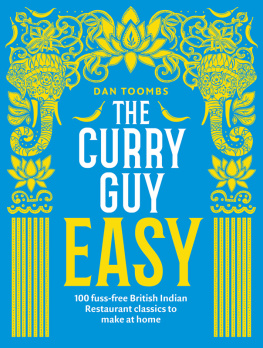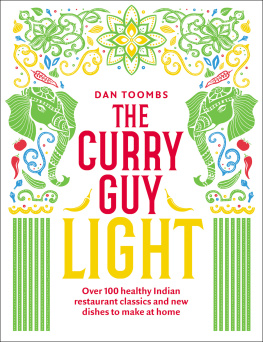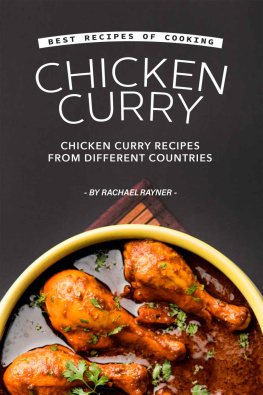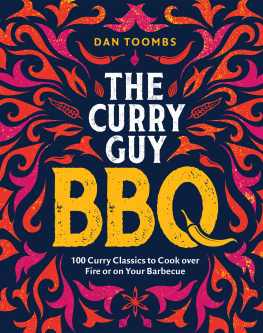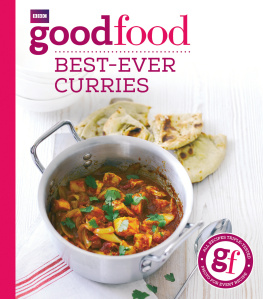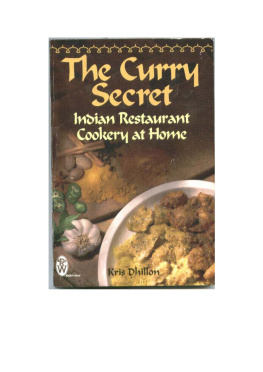CONTENTS
I started writing The Curry Guy blog back in October 2010. I wanted to share a few of the Indian-inspired recipes Id developed while enjoying my passion for cooking. Id been experimenting with Indian cookery for about 15 years so this was a way of taking it all up a notch. The thing was, I didnt want to go to all the work of writing a blog if no one read or tried my recipes. I needed a gimmick.
So it was that in March 2011, I announced to my family that I wanted to cook and eat nothing but Indian food for a whole year. Breakfast, lunch and dinner, we were going to get to know Indian food like few people outside of India did. Assuming that this was just one of my many silly ideas that I rarely followed through, my family agreed to give it a go.
I had opened a Twitter account to help promote my new venture, and shared my recipes there. In the beginning, nothing much happened. Id write and post a recipe and no one seemed to be listening. I was enjoying teaching my kids to cook so I managed not to get too discouraged, and kept writing.
Things took a turn for the better when the Mail Online, the Mirror and the People heard about my quest to eat and cook only Indian food for a year, and published stories about my family and me. We were actually well into our second year by then and the stories worked. That week in 2012 my readership rocketed from hundreds to thousands.
The collection of recipes I have for you are the result of what Ive learned from my visits to many outstanding chefs, and the interaction I have had with my loyal blog readers. You might wonder how a guy from Turlock, California who had never tried Indian food until he was 22 could write about British Indian restaurant (BIR) style meals and, more importantly, get them right. It was my readers who started asking me questions like why is it that the rogan josh in this or that Indian cookbook tasted nothing like the rogan josh they enjoyed at their local curry house? Why was it that chicken tikka masala or chicken korma were different from their local takeaway to when they made it at home? To be honest, I was stumped as I was experiencing the same frustrations.
Things were about to change, however. Where at one time curry-house chefs kept their secret recipes closely guarded, I soon found that they were more than happy to invite me into their kitchens in exchange for a mention on my blog and on Twitter. Many have become friends and people I know I can rely on for recipes and advice.
Whenever I could break away from the day job, I visited restaurants, learning first hand the recipes that millions of people in the UK and around the world wanted. I learned not only the recipes but many tricks of the trade.
In this cookbook you are going to learn to make many of the most popular classic British curries, tandoori dishes and sides, along with getting advice on making them perfect for your personal tastes. These recipes are the real deal! We all have that amazing curry that we must order each time we go out for a Ruby. I hope this book will give you the information you need to make that dish at home.
One thing is certain. In order to get British Indian Restaurant (BIR) style food right, you are going to have to do some forward preparation. Theres no way around this if you want to get it right. Once youve done the prep work though, you will be able to whip up amazing BIR curries in 10 to 15 minutes! In the time it takes to pick up your favourite Indian takeaway, you could be sitting down to a selection of delicious starters, curries, rice and naans that are even better and a lot cheaper.
Undoubtedly, there will be those who scoff at the idea of cooking a curry using a base curry sauce or adding a prepared curry powder. For decades, curry houses around the UK have prepared curries in this way, creating hugely popular dishes with the ingredients that were available to them. These curries arent authentic Indian but they are authentic British curries, and as a nation were crazy about them!
One more thing Id love to help you with any recipe questions you may have. Im just a tweet or Facebook chat away (@TheCurryGuy) and Im here to help.
Happy cooking!
Dan
If you enjoy cooking and great British Indian restaurant (BIR) food, the fun is about to begin. In this cookbook Im going to show you the best kept secrets for making some of the most loved curry-house style curries, tandoori and side dishes at home. Whats more, after you make the essential base ingredients, youll be able to whip up the classic British curries in just ten minutes. They will taste as good as, if not much better than those produced at your favourite Indian takeaway or restaurant. As much as I do love dining out, Ive saved one heck of a lot of money and enjoyed some amazing curry feasts with friends and family at home, and you can too.
I came up with these recipes after watching them being made many times at restaurants, taking notes and photographs and, of course, through a good deal of experimentation. Its the experimentation that I found most enjoyable. Like me, you will learn not only the famous recipes but also be able to tailor them to your own tastes and dietary requirements.
With this in mind, please feel free to adjust the recipes to your own personal tastes. If you want more coconut or sugar in your chicken korma, add it. If my lamb Madras isnt spicy enough for you, add some more chilli powder or fresh chillies. If lamb vindaloo doesnt appeal to you but king prawn and mushroom vindaloo does, why not?
Remember, were not baking cakes here. An extra teaspoon of curry powder or a little less garlic and ginger paste than called for wont ruin your curry. One exception to this is when adding chilli powder and fresh chillies. If youre not sure about the spiciness, always use less than called for. You can always add more to taste but it is difficult to cool a curry down once added.
WEIGHTS AND MEASURES
Id like to emphasize that during my many visits to curry-house kitchens, I was rarely given exact ingredient measures for different recipes. Carefully measuring a tbsp of this or a teaspoon of that just isnt done in busy Indian restaurants. I have yet to see a curry-house chef using kitchen scales, measuring spoons or jugs. Everything is eyed up on the spot and added until the dish they are making looks, tastes and smells just right.
The only measuring tool they use is their handy chefs spoon. This is a long-handled spoon that holds 30ml, so its the equivalent of 2 tbsp. They dip this spoon into large sauce, spice and paste containers and take out what they need. Its like watching a conductor, with the containers of spices and other ingredients all part of the symphony orchestra.
When writing these recipes, I used heaped generous tablespoon and teaspoon measures. After watching these chefs simply dip their big spoons into this or that ingredient and transferring it to the curry, it just didnt feel right to take a tbsp of a spice and then carefully flatten it off into a level tbsp. This just isnt that kind of cooking; its much wilder.
So please use my recipes as a guideline. They are the way I make them at home, although admittedly I worked out the exact measurements for this book. After you make a few recipes, youll soon learn how much of this or that ingredient to add to make the perfect BIR feast for you, your family and friends.


